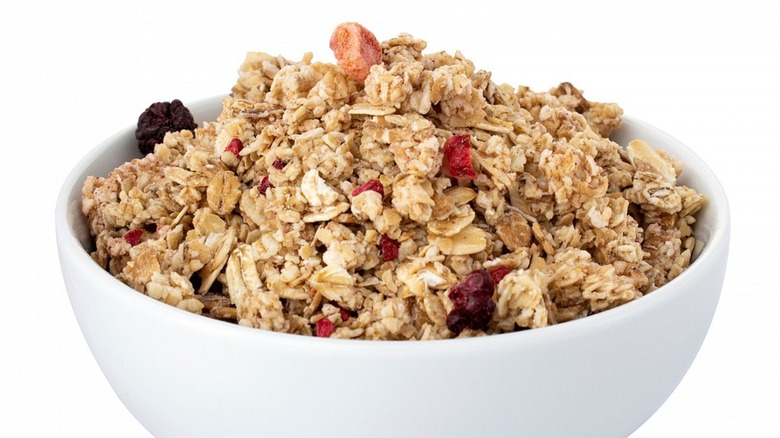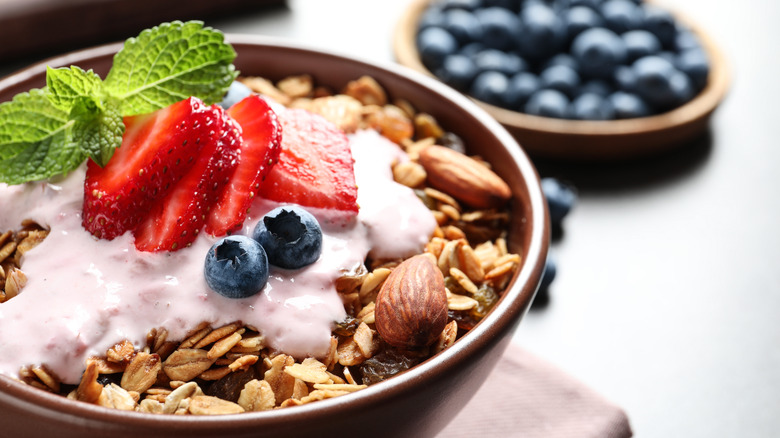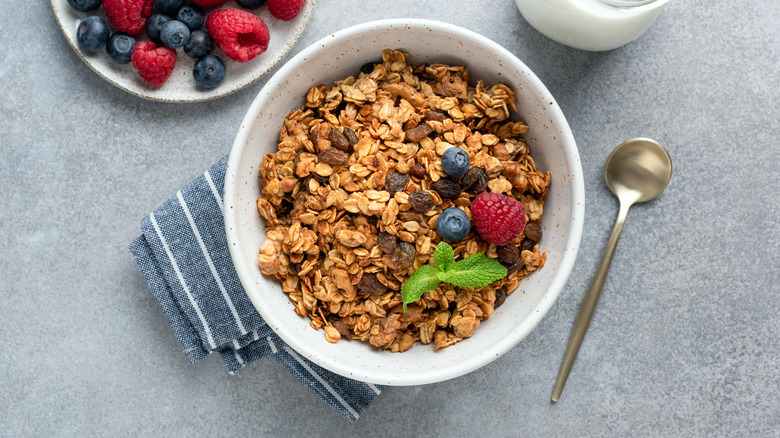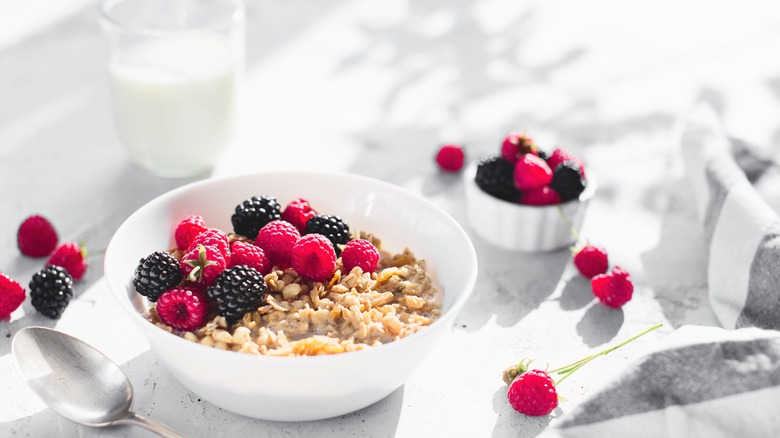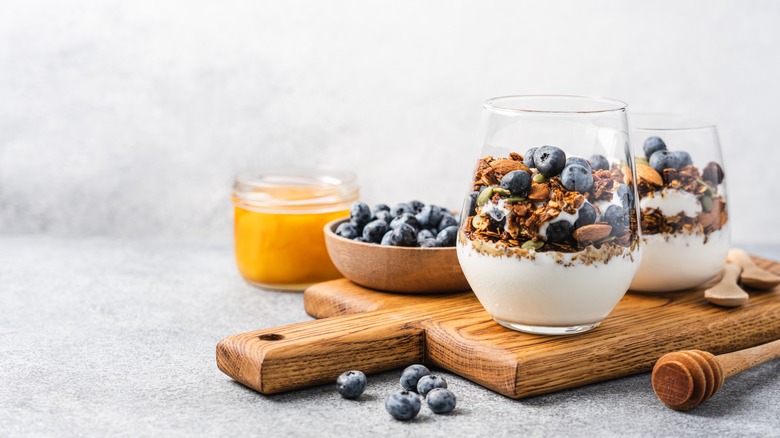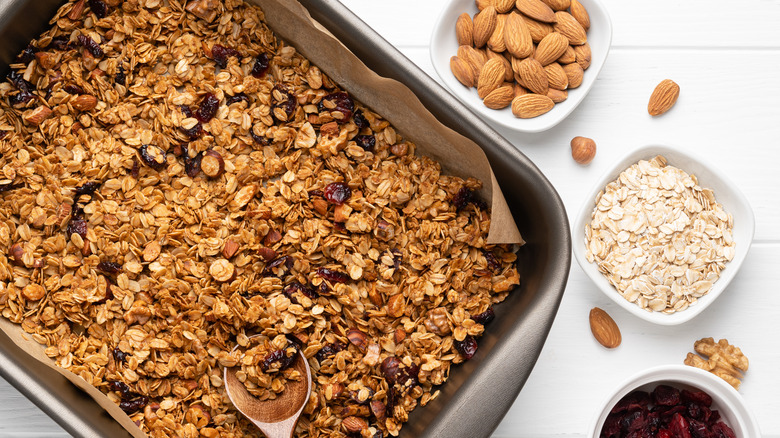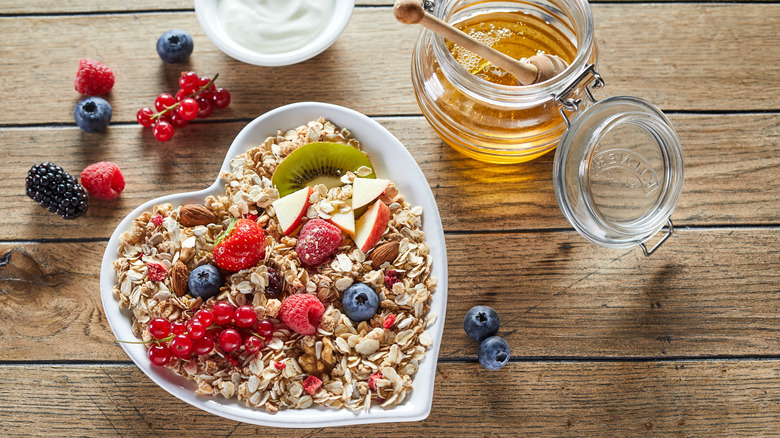Granola Vs. Muesli: What's The Difference?
They don't just call breakfast the most important meal of the day for no reason. The first meal of the day is meant to fuel the body after hours of not eating and a well-rounded breakfast can make up for a good deal of vitamins and nutrients required for the day ahead (via Johns Hopkins Medicine). Eating the right foods can help with digestion, keep your bones strong, and even help keep your weight and bad cholesterol levels in check.
Those who eat breakfast items with milk, for example, are able to get a good deal of calcium, protein, and vitamin D in one meal alone. Those who eat oats, on the other hand, can get even more protein along with healthy carbs and fiber in their breakfast (via Healthline). And those who manage to pack in both in their breakfast are probably onto a solid start for the day.
Luckily, there are two types of cereal that are both made using oats and are primarily eaten with milk: granola and muesli (via Healthline). With supermarkets selling an ample variety of each, they are both easy-to-put-together breakfast items at home; contain a good mix of oats, fruits, and nuts; and are comparatively more nutritious alternatives to sugary sweet cereals. But while it may seem like granola and muesli are two words for essentially the same oat-based cereal, there are several subtle differences between the two.
What is granola?
Cereals can be made from all sorts of grains — rice, wheat, corn, quinoa, barley, and even sorghum. Granola for one, is made mostly using oats (via Healthline). While rolled oats make up the major chunk of granola, the cereal often comes with all sorts of mix-ins, including nuts like almonds and walnuts, dried fruits like cranberries and raisins, seeds like pumpkin and watermelons seeds, and in some cases, even other grains like quinoa.
More importantly, granola is always baked which is why it also has sweeteners like honey or maple syrup and oils that help bring the nut, seed, and oat mixture together (via Fit & Flex). The mixture is then baked into tiny but crunchy clusters.
Because there isn't a standard recipe for granola, it's common to find bags that also come with chocolate, nut butters, spices, and all kinds of added sugars. While granola is meant to be a nutritious and filling breakfast cereal, its exact nutritional value will vary depending on what exactly lies inside a particular bag of granola.
The origin of granola
It may come as a surprise that it wasn't Froot Loops that put the cereal giant Kellogg's on the map. Rather, it was the humble granola. According to The New York Times Magazine, granola was first invented by Dr. James Caleb Jackson in 1863 who used a graham flour and water mix, baked it twice, and broke it into brittle pieces that were only edible when soaked in milk all night. Originally called "granula," the cold cereal was created to treat people at Dr. Jackson's New York-based sanitarium as a nutritional supplement of sorts.
Soon after, Dr. John Harvey Kellogg happened to make his own version of granula in his sanitarium in Michigan using wheat flour and oatmeal instead of graham flour. The Food Historian speculates that the two doctors were likely inspired by German rusks, zwieback, or hardtack — a bread that was baked twice and eaten after being softened with liquid by soldiers.
Regardless of the common source of inspiration, Dr. Kellogg was slapped with a lawsuit by Dr. Jackson for his granula, upon which he cleverly switched a vowel in his cold cereal and gave it a new name: granola.
What is muesli?
Museli was invented by Dr. Maximilian Oskar Bircher-Benner, a Swiss physician who sought to treat the effects of tuberculosis through a healthy diet using raw food (via BBC Travel). He then came up with what he called the "Apple Diet Meal": a mix of oats, apples, nuts, lemon juice, water, and condensed milk. Bircher-Benner's muesli at the time wasn't meant for breakfast alone and was instead considered an appetizer that could be eaten before any meal or as a light supper by itself.
Decades later, the essence of muesli remains the same except now, it's mostly considered a breakfast item and the ingredients look a tad different. Muesli too is made using pretty much the same ingredients as granola, in that it is an oat-based cereal with nuts, dried fruits, and seeds (via Healthline). Museli could easily have passed off as granola except there's one main difference: Muesli isn't baked. While it may seem like an insignificant difference at first, the fact that muesli isn't baked into clusters and is a raw and loose mix of ingredients greatly affects the way in which it is eaten.
How to serve and eat each?
While granola and muesli are both oat-based cereals usually eaten for breakfast, the fact they are prepared differently affects how they are eaten. Because muesli is raw, it is most often soaked in milk overnight till it sets into a creamy porridge-like consistency similar to overnight oats (via Fit & Flex). Alternatively, muesli can be eaten without any overnight soaking and straight from the box alongside milk or yogurt. It can also be boiled in water or milk to make a hot muesli porridge (via Healthline).
Granola, on the other hand, is rarely soaked. Because the oat, nut, fruit, and seed mix is baked twice, granola is sought for its crunchy texture which muesli lacks. As a result, granola is often used as a topping over yogurts, smoothie bowls, oatmeals, and toasts. Granola can even be eaten straight from the bag as an energizing snack and as a result, it's also common for the oat-based mixture to be pressed into rectangular granola bars with the help of liquid sweeteners and binders like honey or corn syrup (via MasterClass).
Which one is more nutritious?
The exact nutritional values of muesli and granola vary depending on what's inside the bag that you're buying and so, it can be hard to determine which one is healthier. Both muesli and granola contain beta-glucans from oats — a type of fiber that aids with weight loss and helps regulates blood pressure, cholesterol, and blood sugar (via Healthline). Nevertheless, there are a few things to keep in mind when using either.
Because muesli isn't baked like granola, it usually doesn't come with any sweeteners and has a lower content of sugar, carbs, and calories as compared to granola. But that isn't enough to give muesli an edge as Healthline warns that muesli still has a high amount of sugar from dried fruits which though a healthy ingredient, must be eaten in moderation. Muesli also uses raw oats which when not soaked in liquid, have high amounts of the antinutrient phytic acid.
It's also important to take into account the fact that granola is most often eaten as a topping whereas muesli is used as the main ingredient, meaning their portion sizes will greatly differ. Any advantage that you'd have from muesli's lower carb, calorie, and sugar content may be lost when you consider the usual serving size of granola, which is 28 to 56 grams and contains 7 to 15 grams of sugar, compared to a 43- to 65-gram serving typical of muesli with 11 to 16.5 grams of sugar.
What should you consider before buying muesli or granola?
A registered dietician told Time that there are a few things that you should be on the lookout for when you're buying a box of cereal from the store, especially if it's granola which tends to come with sweeteners. For one, it's important to scan the ingredient list on the back of the bag for any hidden sugars like anhydrous dextrose, maltose, dextrose, and corn syrup solids among others. The higher the ingredient is on the list, the higher its proportion is going to be inside the bag.
When it comes to muesli, it's easier to find one that doesn't have any sweeteners in it at all (via Healthline). Avoiding muesli and granola with additional sources of sugar from ingredients like candied fruits and chocolate will also go a long way in keeping the sugar content down. It's also important to consider any dietary restrictions as both muesli and granola tick pretty much every allergen box, including all kinds of nuts, seeds, grains, and in some cases, even dairy. Any amount of trans fat or high amounts of saturated fats from oils, which can raise bad cholesterol levels, is another thing to watch out for, especially in granola.
Alternatively, you could always make your own muesli at home. Considering muesli doesn't even need to be baked, it's as easy as throwing everything together in a bowl and calling it a day! If it's homemade granola that you fancy, this Mashed recipe will bring it to life in all but 15 minutes.
